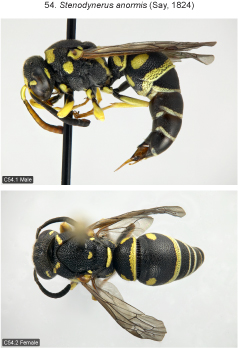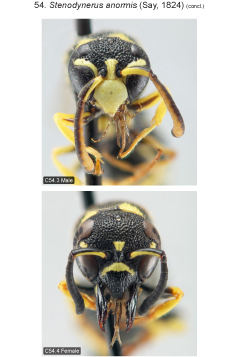
| Home | Table of contents | Keys | Species list | Glossary | Image data | PDF | Cite this article | Feedback | Updates |
Identification Atlas of the Vespidae (Hymenoptera, Aculeata) of the northeastern Nearctic region
CJAI 05, February 19, 2008
doi: 10.3752/cjai.2008.05
Matthias Buck, Stephen A. Marshall, and David K.B. Cheung
Department of Environmental Biology, University of Guelph, Guelph, Ontario, Canada N1G 2W1
Next species | Previous species | Key
54. Stenodynerus anormis (Say, 1824)
Figs B7.24, 61; C54.1–4.

|

|
Species recognition. This species shows the characteristics of the S. anormis-group (apically truncate clypeus and deformed male mid femur). Diagnostic characters separating S. anormis from S. ammonia (the only other species of the S. anormis-group occurring in the northeastern Nearctic) are mentioned under that species. The female of S. oculeus, which sometimes also has an apically truncate clypeus, can easily be distinguished by the interocellar tubercles (absent in S. anormis), the medially interrupted pronotal carina (entire in S. anormis), medially interrupted fascia of tergum 3 (entire in S. anormis) and bright yellow metasomal markings (becoming paler on posterior segments in S. anormis). Further diagnostic characters not mentioned in the key include short bristly hairs on posterior surface of male flagellomeres I–VIII (becoming longer on more apical segments), and a yellow frons between antennal socket and upper margin of clypeus in male (black in all other species except S. fundatiformis).
Variation. Fore wing length 4.5–6.0 mm (♂♂), 6.0–7.5 mm (♀♀). Female clypeus with a yellow crescent-shaped dorsal mark, rarely thin and (sub-)interrupted laterally and/or medially or reduced to small median spot(s). Interantennal spot restricted to area above interantennal prominence in female, always extending to clypeus in male. Posteromedial spot of scutum rarely missing in female, absent in males from east, but sometimes present and minute in western specimens, very rarely of moderate size. Propodeum in female with a pair of yellow stripes on each side on propodeal concavity, sometimes extending to propodeal dorsum; propodeum similarly marked in male, sometimes propodeal stripes interrupted at level of propodeal angle, rarely propodeum almost completely black. Female terga 1–5 and male terga 1–6 with apical fasciae, fascia of tergum 3 complete. Discal spots of tergum 1 separate or connected to apical fascia. Female sternum 2 usually with broadly interrupted apical fascia, sometimes interrupted narrowly and rarely almost complete; sternum 3 and sometimes 4 with apicolateral pale spots. Male sterna 2–4 with apical fascia, frequently interrupted medially and/or laterally on sterna 3 and 4; sternum 5 with pale with apicolateral spots. Male sternum 2 usually with a pair of pale discal spots.
Distribution. Transcontinental and widespread in Canada and the U.S. (Krombein 1979). Mexico: Baja California (Rodríguez-Palafox 1996). We have seen Canadian specimens from ON, MB, SK, AB and BC.
Biology. The species has been reared from cells in a pithy stem, the cells being separated by mud partitions. Prey are caterpillars (Krombein 1979). We suspect that the species also nests in the ground. In 2004 the senior author observed females entering ground burrows at two different occasions in Guelph, ON. In neither case did the female carry any prey or engage in burrowing activity that was visible to the observer. Both burrows were in very hard-packed soil, had clean-cut exit holes and completely lacked tumuli or loose earth in the perimeter that could be attributed to recent burrowing activity. The burrows were found on a sparsely vegetated, empty lot that had been bulldozed probably a decade earlier. It is unclear whether the burrows were made by the wasps themselves.
Next species | Previous species | Key
| Home | Table of contents | Keys | Species list | Glossary | Image data | PDF | Cite this article | Feedback | Updates |
